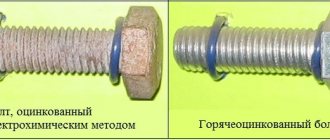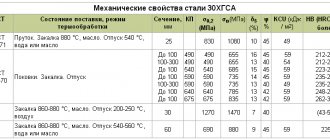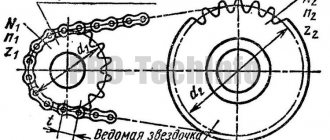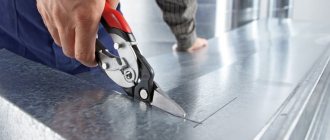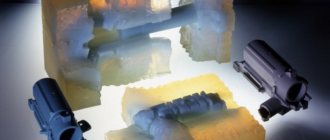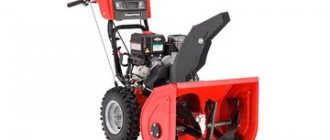- Home >>
- GOST >>
- GOST sheet >>
Sheet and coil cold-rolled steel, hot-dip galvanized in continuous galvanizing units, intended for cold profiling, for painting, for the manufacture of stamped parts, dishes, containers and other metal products, is produced in accordance with GOST 14918-80.
Galvanized thin sheet steel (GTS) is divided into:
- by assignment to groups:
- ХШ - for cold stamping,
- HP - for cold profiling,
- PC - for painting (trained),
- OH - general purpose;
- N - normal hood,
- G - deep drawing,
- VG - very deep drawing;
- Hli - with normal thickness variation,
- UR - with reduced thickness variation.
By agreement between the consumer and the manufacturer, galvanized steel can be produced:
- KR - with a crystallization pattern,
- MT - without crystallization pattern.
Galvanized steel is produced:
- width from 710 to 1800 mm inclusive;
- thickness from 0.5 to 2.5 mm inclusive.
Depending on the thickness of the coating, galvanized steel is divided into three classes in accordance with those indicated in the table.
Corrugated sheet covering
First, let's decide on the appearance of the material. The corrugated sheet can be simply galvanized without a polymer coating or with a polymer coating.
In both cases, the steel sheet is coated with a zinc compound that protects the material from corrosion. This is realized by the hot method, when the sheets are immersed in molten zinc, or by the electrolytic method, when zinc powder settles on the surface of the steel during the electrolysis process.
Needless to say, regular galvanizing without a polymer coating will be the cheapest option to use. Such a sheet is not suitable for the roof of a residential building, but using it on the roof of a garage, utility room or other auxiliary building is quite justified. The service life of such corrugated sheets is 10-12 years and manufacturers rarely give a guarantee for their rental for more than 2 years.
Corrugated sheeting with a polymer coating will last much longer on the roof. To do this, additional production steps will include priming on both sides of the profiled galvanized sheet and subsequent spraying of a polymer coating on one or both sides. The polymer coating, in turn, can be glossy (the most budget-friendly solution is polyester) or matte (more expensive coatings based on polyvinyl chloride).
Marking of corrugated sheets
Regulatory documents and GOSTs oblige manufacturers to label their products. Depending on the marking, the profile can be:
- Stenov. In this case, it is marked with the letter “C”. This profile is proposed to be used on vertical surfaces, since the height of the profile is not high (from 8 mm to 44 mm), and the thickness starts from 0.35 mm and does not exceed 0.6 mm. However, the load-bearing capacity of wall corrugated sheeting allows its use to cover a roof with a large angle of inclination, provided that a reliable rafter system or even a continuous sheathing is installed.
- Bearing. For roofing, a corrugated sheet marked with the letter “H” is recommended. The height of the profile is significantly higher than that of a wall profile (up to 114 mm); accordingly, the stiffening ribs provide greater load-bearing capacity. This material is made of steel up to 0.9 mm thick, so it can withstand significant weight loads. The use of such corrugated sheeting is possible even on flat roofs.
- Universal. The characteristics of this profile allow it to be used for all types of construction work. Universal type corrugated sheets marked “NS” have average characteristics of profile height and sheet thickness. This profile is suitable for both fences and roofs with any slope.
It should be noted that this or that marking does not oblige the consumer to use corrugated sheets only in accordance with it. When choosing a material, many factors should be taken into account, for example, the purpose of the building, the angle of inclination and length of the slope, features of the rafter system, and so on. The lower the roof slope and the shorter the pitch of the sheathing, the higher the profile is required.
Application area
Profiled sheet is a building material and is used as:
- roofing;
- facing wall;
- material for enclosing structures (fence, facade);
- formwork for the construction of monolithic reinforced concrete floors;
- sandwich panels.
The area of application of a specific profiled sheet is indicated by special markings:
- C - wall;
- N - bearing;
- NS - load-bearing wall;
- PC - corrugated roofing;
- MP - universal (for walls, roofs, sandwich panels);
- PG (“longitudinally bent”) - profiled sheets with this marking are used for the construction of arched structures, arched canopies, hangars.
You need to understand that the declared type of corrugated sheeting is just recommendations from the manufacturer. You must take into account the technical conditions of the facility where you will use the corrugated sheet, the conditions and service life. For example, if you are making a gazebo or a small extension to a house with continuous sheathing, then a simple C8 wall profile sheet will suit you. And if you need a high fence and there are strong winds in your area, then it would be better to use reinforced profiled sheeting.
Sheet thickness
What thickness of corrugated sheeting is best for the roof?
Manufacturers offer the consumer sheets from 0.37 to 1.2 mm. For the roof of a residential building, it is optimal to use thicknesses in the range from 0.45 to 0.55 mm. The thicker the material, the more expensive it will be and the final cost will be comparable to the price of metal tiles, for example, which, nevertheless, has superior characteristics, all other things being equal.
Roofing profile
Which brand or type of corrugated sheeting is more suitable for the roof? The most popular are profiles with corrugation heights from 8 to 21 mm. The height of the wave (corrugation) is responsible for the load-bearing capacity, strength and reliability of the finished roof.
According to the standards, a profile marked C8 is considered a wall profile, however, such corrugated sheeting is often used on the roof of outbuildings, which is quite acceptable. But the angle of inclination of the slope should be 45 degrees or more, a continuous sheathing is highly desirable, and in places where ventilation or chimneys exit, additional sheathing is necessary. The thickness of the metal in this case should be no less than 0.45 mm, and even this does not guarantee that when moving on such a roof, if necessary, the metal will not be pressed through. It is better to increase the overlap of sheets during installation by two waves to avoid leaks during rain or when snow melts.
C20 corrugated sheeting is most often used on the roof. Its wave height is 18 or 20 mm (depending on the manufacturer), which increases the load-bearing capacity. The optimal thickness is selected 0.45 or 0.5 mm. Let us note once again that the strength of the roofing covering and the ability to withstand significant loads, be it snow or the weight of the person servicing the roof, depend on the thickness of the metal and the height of the profile. The thicker and higher the profile, the better.
Despite the fact that this corrugated sheeting is marked with the letter “C” and is intended for vertical surfaces, some manufacturers offer this profile with the mark “R”, which means roofing. And all because it differs from the usual C20 profile by the presence of a capillary groove. This special recess is a small groove pressed along the outer wave. During installation, it will be covered with a top sheet. The purpose of the capillary groove is to prevent moisture from entering the under-roof space.
Profile C21 is similar in appearance to C20, but has a corrugation height of 21 mm, the wave width is equal to the wave pitch and is 35 mm, which visually makes such corrugated sheeting more attractive.
Profile NS35 is the initial brand of full-fledged roofing corrugated sheeting. The 35 mm high trapezoidal waves make it particularly durable. If we look at the profile drawing, we will see semicircular grooves in each lower and upper wave; they play the role of additional stiffening ribs. In the edge zone of the corrugated sheet there is a capillary groove for draining the resulting condensate. Most often, NS35 is mounted on the roof of non-residential structures, garages or sheds.
The H60 profile is made from fairly high quality steel, the thickness of which is usually from 0.7 mm. The wave height of 60 mm and additional stiffening ribs make it so durable that the service life of such a roofing coating will be 50 years or more. There is also a groove along the working edge of the sheet to drain condensate. Such a high and durable profile, and as a result, more expensive, is advisable to use in regions with heavy snow and wind loads.
It is worth noting that despite the fact that high profiles NS35, H60 and so on have a significant margin of safety, their use on the roof of a private house is not economically profitable, since due to the significant wave height and the thicknesses of the steel sheet used, reinforced sheathing is necessary for such corrugated sheeting, which increases the cost of work, and the metal itself will cost much more than lower profiles. The roof of a house covered with H60 with a budget polyester coating is comparable in cost to a metal tile roof with an expensive, higher quality Quarzit or Velur coating. And such a roof will look much more aesthetically pleasing and attractive.
Galvanizing class
Another important point that you should pay attention to when purchasing any profiled products is the amount of zinc applied to the rolled product. The degree of susceptibility of the metal to corrosion depends on it. Unfortunately, the buyer will not be able to visually evaluate this parameter, however, a responsible manufacturer will definitely provide regulatory documents and certificates of conformity for the metal, which will indicate the galvanizing class. There are 3 classes, the zinc content of which is indicated below:
Metal with the second class of galvanizing is the most affordable and is more often offered to customers who purchase inexpensive corrugated roofing.
Metal with the first and higher (P) class is recommended for use in regions with increased atmospheric loads or at critical industrial facilities in our region.
Galvanization
Galvanization is carried out using the hot-dip galvanizing method - the product is dipped into a bath of molten zinc at a temperature of about 460 °C. In air, zinc (Zn) reacts with oxygen (O2) to produce zinc oxide (ZnO), then reacts with carbon dioxide (CO2). The result is a fairly durable matte gray film made from zinc carbonate (ZnCO3).
Galvanization class of corrugated sheets
There are 3 classes of galvanization. They differ in the mass of zinc applied on both sides to the metal product per 1 sq.m. As an additional parameter, the resulting thickness (µm) of the zinc coating is indicated.
| Galvanization class | Zinc consumption (g/m2) | Layer thickness (µm) |
| Increased class (marked “P”) | 570-855 g/m2 | 40-60 microns |
| 1 class | 258-570 g/m2 | 18-40 microns |
| 2nd grade | 142-258 g/m2 | 10-18 microns |
Scope of application of different classes of galvanization
The upgraded class is more intended in unfavorable climates (sea climate, dust, snow) and in areas with an aggressive environment (industrial enterprises).
The first class is mainly used in private construction and more often due to price, because it is cheaper.
The second class of coating is more often used on construction sites where service life is measured in months. These can be temporary fences, cabins, etc.
Sheet dimensions
The width of each profile brand is standard, for example, C8 has a total width of 1200 mm, and profiled sheet C20 has a total width of 1150 mm. Any length of rolled metal is possible up to 12 meters. This is very practical if it is necessary to cover long slopes of 4 meters or more, since it allows you to avoid horizontal joints, which has a positive effect on the tightness of the roof. However, when the length of the slopes is 6...8 meters or more, it is not recommended to order corrugated sheets (especially with a low profile C20 or C21), since such a length will complicate the lifting of the metal onto the roof and there is a risk of deformation of the corrugation due to the large mass of the sheets. And transportation of long items will cost much more, since large-sized vehicles will be involved.
Total and usable width
Rolled thin sheet steel, which is used to make corrugated sheets, has a standard width of 1250 mm. After running on a rolling mill, the width of the profiled sheet changes due to the formation of corrugations. The more corrugation and the higher it is, the smaller the width of the resulting profiled sheet. For example, the width of C8 corrugated sheet is 1200 mm, and the width of H75 corrugated sheet is already 800 mm.
The total width is the actual width of the profiled sheet. Useful width is the width of the part of the corrugated sheet that does not overlap with another sheet during overlap installation. Those. the useful width multiplied by the number of corrugated sheets is the width that these corrugated sheets will cover after overlapping installation.
But the declared useful width is not always what it actually is. For example, if you use a profiled sheet as a roofing material, then for flat roofs it is recommended to install the sheets with an overlap in two waves (which reduces the usable width) so that during heavy rains and melting snow on the roof, water does not seep through at the joints.
For profiled sheets, a standard has been developed in Russia - GOST 24045-94 (Bent steel sheet profiles with trapezoidal corrugations for construction), which strictly regulates the dimensions of the corrugated sheet and other parameters of the material, including the thickness of galvanization.
